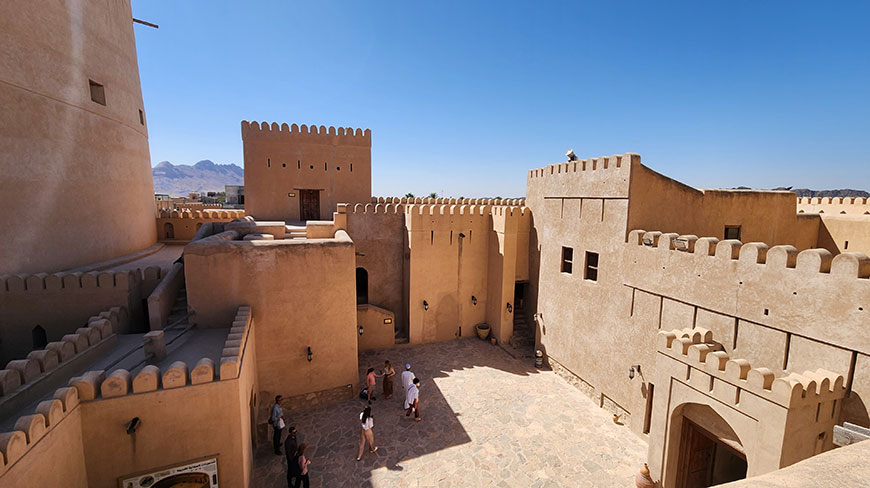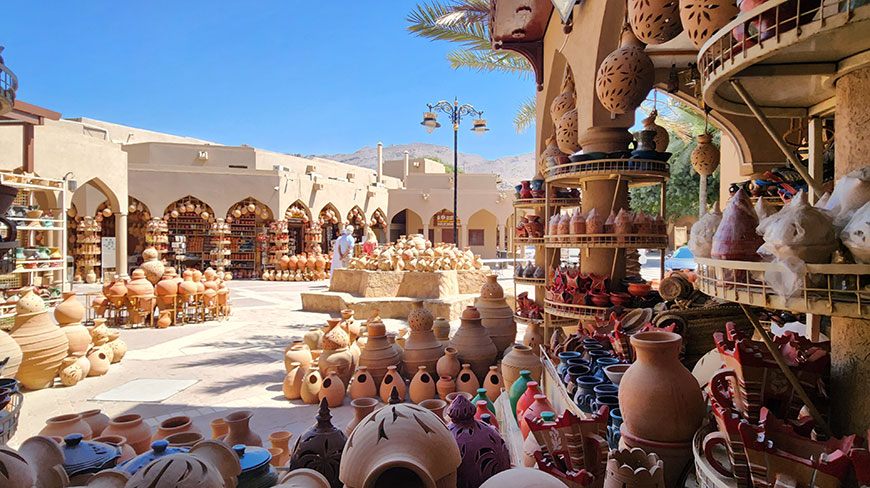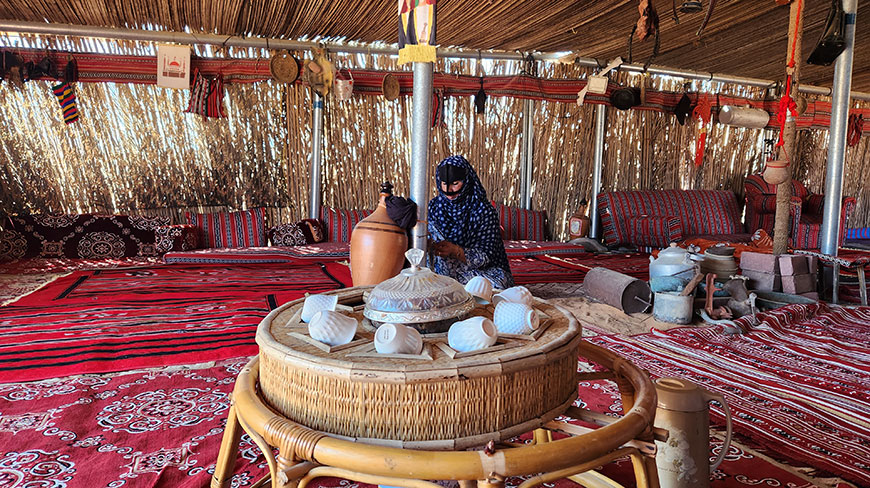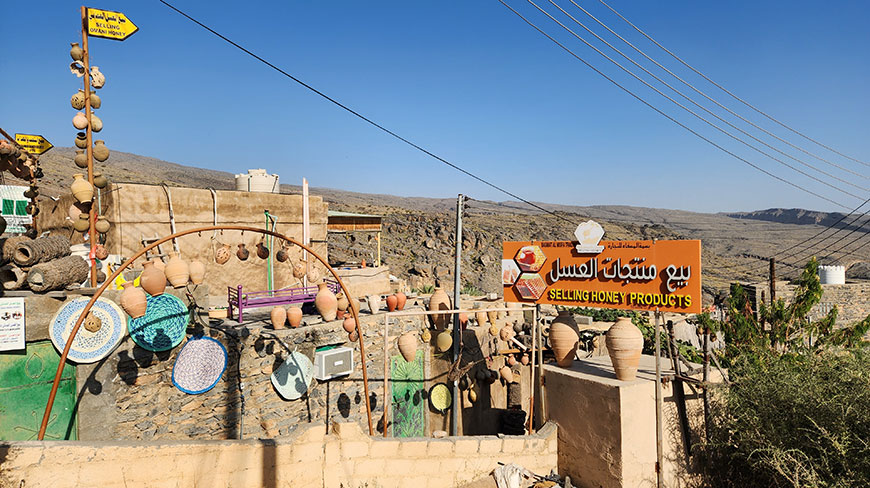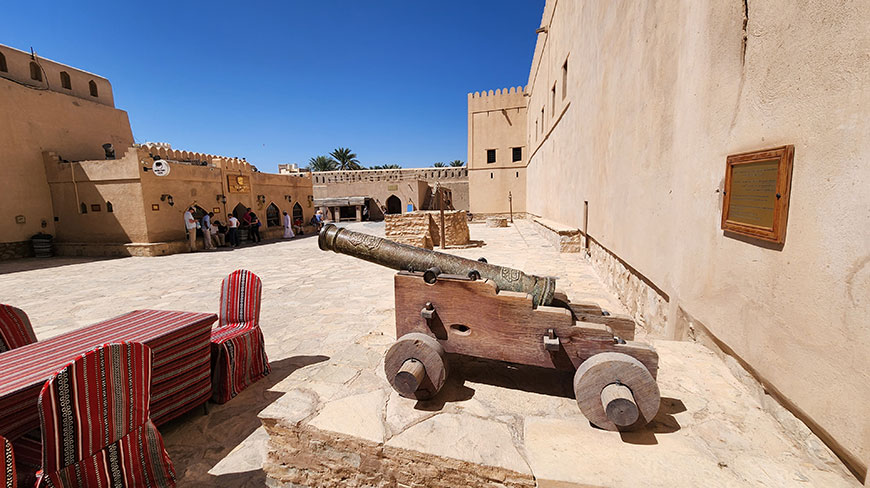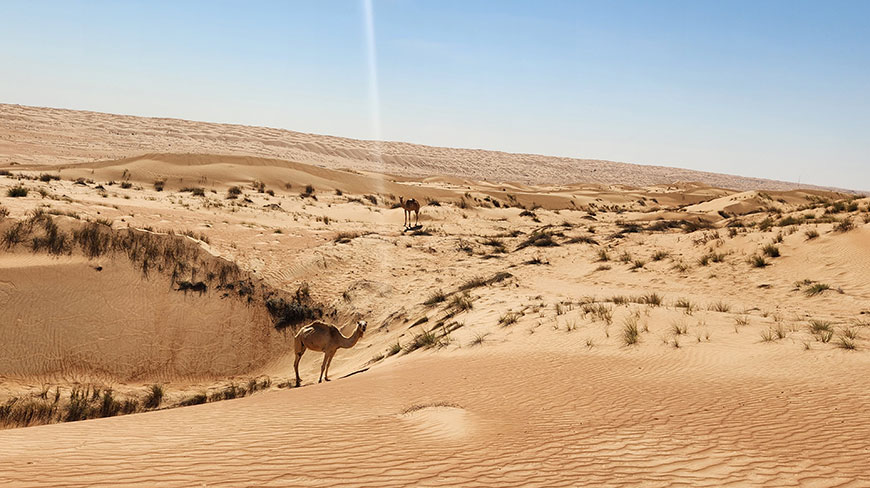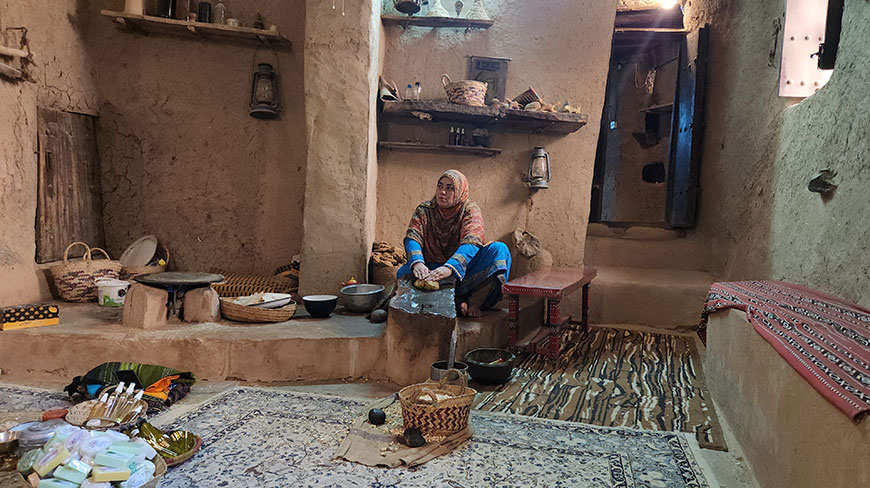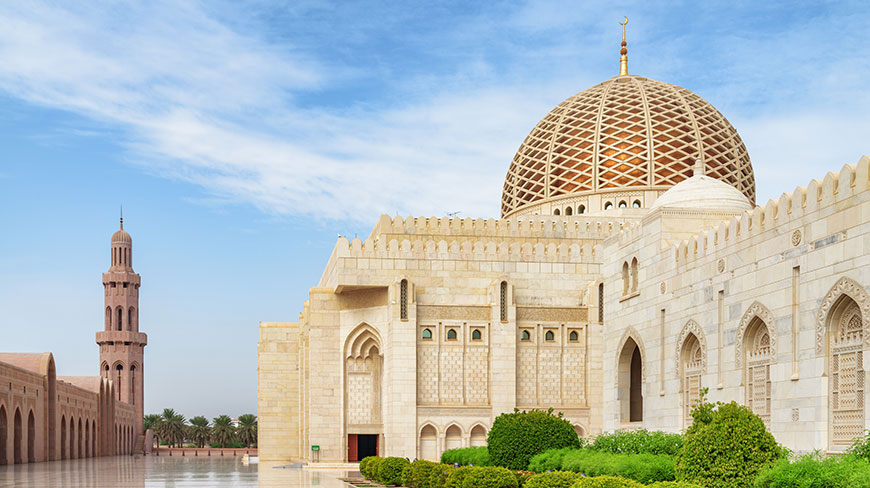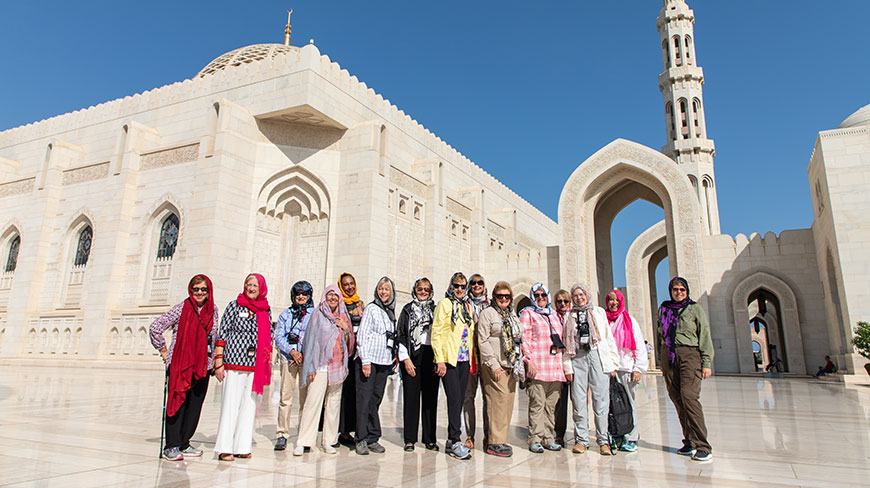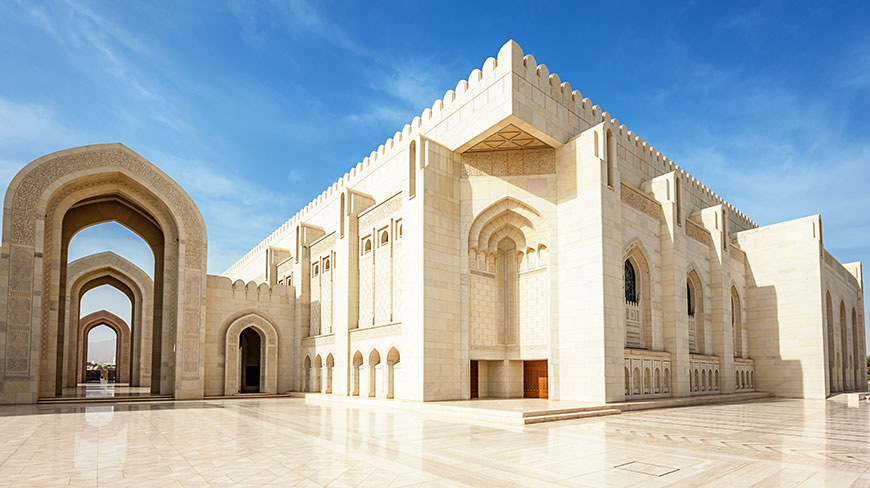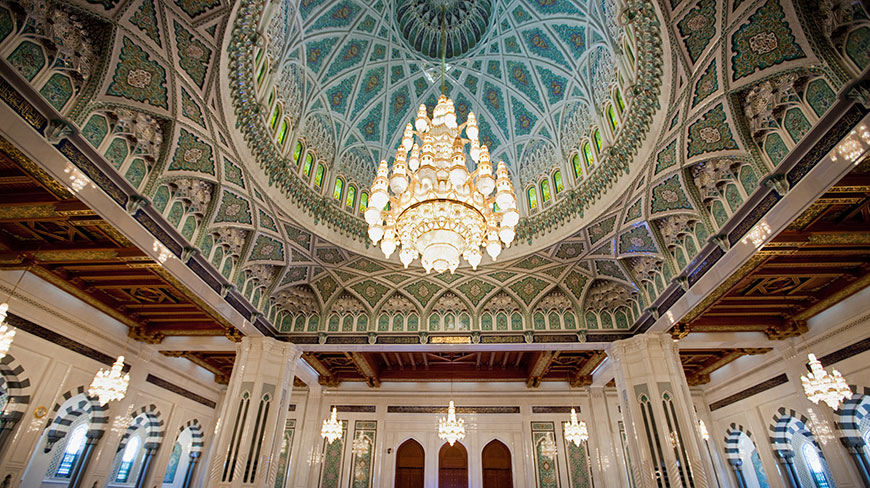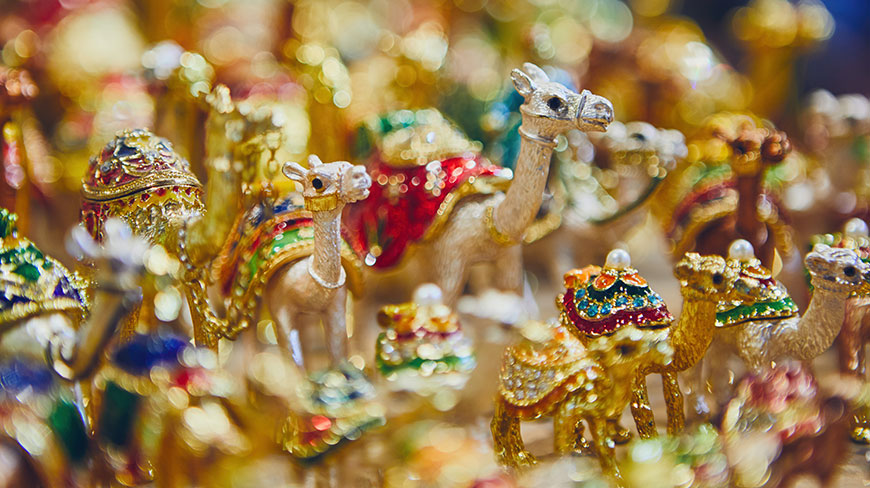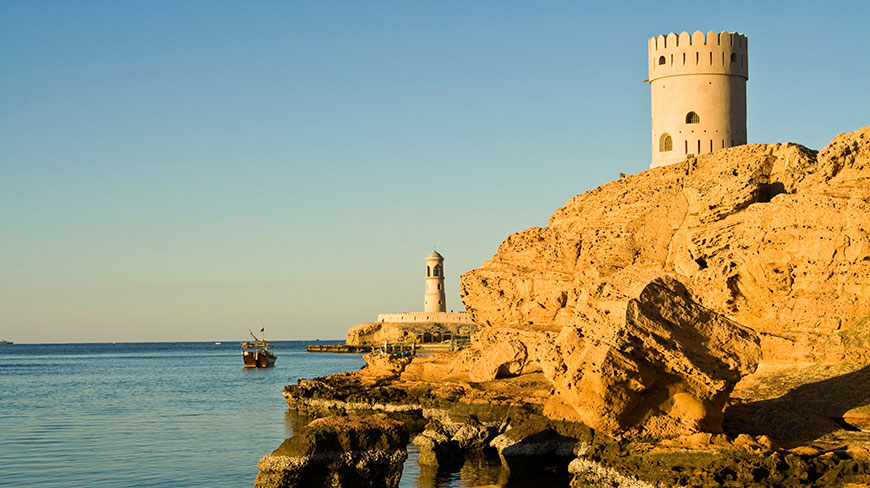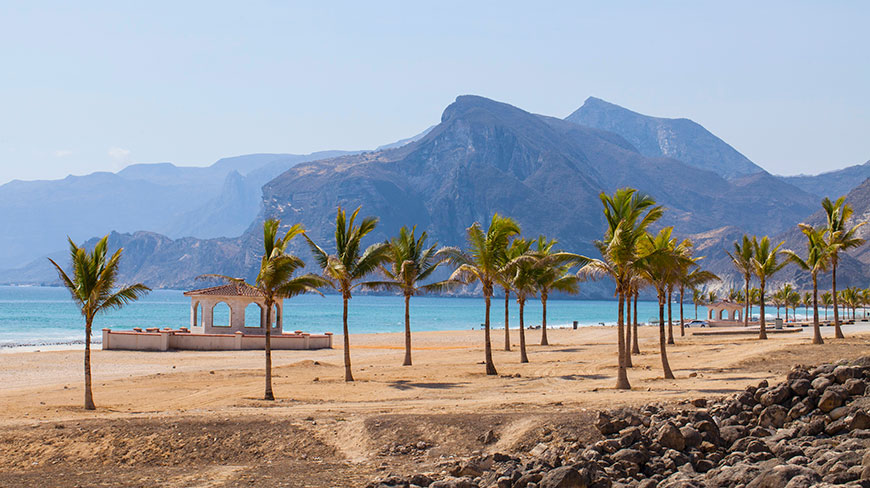Oman
The Best of Oman: Arabian History and Heritage
Program No. 25494RJ
From 5,000-year-old tombs to modern cities and culture, discover how the past has influenced the present in Oman through explorations of mountain villages, markets and deserts.
Itinerary
While we make every effort to ensure the accuracy of our published materials, programs are typically advertised more than a year prior to their start date.
Read More.
While we make every effort to ensure the accuracy of our published materials, programs are typically advertised more than a year prior to their start date. As a result, some program activities, schedules, accommodations, personnel, and other logistics occasionally change due to local conditions or circumstances. Should a major change occur, we will make every effort to alert you. For less significant changes, we will update you during orientation. Thank you for your understanding.
Duration
13 days
12 nights
What's Included
24 meals (
11B, 6L, 7D
)
27 expert-led field trips
2 flights during the program
1 hands-on experience
An experienced Group Leader
11 nights of accommodations
Taxes and customary gratuity
Road Scholar Assurance Plan
Day
1
In Transit to Program
Location:
In Flight
Activity Note
Depart North America on overnight international flights to Muscat, Oman. Refer to your personal air itinerary for specific flight information.
Day
2
Arrive Muscat, Check-in
Location:
Muscat
Stay:
Radisson Blu
Activity Note
Hotel check-in from 2:00 p.m. Remember to bring your nametag (sent previously).
Dinner:
With typically evening flight arrivals, dinner is independent.
Evening:
After checking in to the hotel and getting your room, settle in, and get a good night’s rest for the days ahead.
Day
3
Mutrah Souq & Corniche, National Museum of Oman
Location:
Muscat
Meals:
B,L
Stay:
Radisson Blu
Activity Note
Walking 1-3 miles throughout the day on paved sidewalks; periods of standing during field trips. Getting on/off a bus. Driving 1-2 hours.
Breakfast:
At the hotel
Morning:
Orientation: 9:00am. The Group Leader will greet everyone and lead introductions. We will review the up-to-date program schedule, discuss roles and responsibilities, logistics, safety guidelines, emergency procedures, and answer questions. We will learn from the Group Leader as well as local experts who will provide lectures and lead some field trips. Periods in the schedule designated as “Free time” and “At leisure” offer opportunities to do what you like and make your experience even more meaningful and memorable according to your personal preferences. The Group Leader will be happy to offer suggestions. Program activities, schedules, personnel, and indicated distances or times may change due to local circumstances/current conditions. In the event of changes, we will alert you as quickly as possible. Thank you for your understanding. After orientation, we will then set out on our exploration of capital of Oman, Muscat. We will visit the picturesque Sultan Qaboos Grand Port and Mutrah Corniche, which has long been a center of commerce in Oman, and the nearby souq, or market, is one of the oldest and largest historical marketplaces in Oman. While dating back an impressive 200 years, the current Mutrah Souq only represents a portion of its legacy as an important stop along ancient maritime trade routes for millennia. Today it’s a great place for Road Scholars to observe a bustling local marketplace and also find souvenirs like traditional Omani daggers and textiles. We’ll also stop by the Mutrah fish market to view the diverse catch from the tropical waters off Muscat. Crustaceans, fish big and small, rays, and much more are on offer, all fresh from the nearby ocean.
Lunch:
Welcome lunch at a local restaurant
Afternoon:
After lunch, we will explore the National Museum of Oman which is located opposite the Sultan’s Al Alam Palace, separated only by gates and the open space of Palace Square. The museum is immense; Oman’s largest and most important. Fourteen galleries feature topics ranging from ethnography, maritime history, and the traditional UNESCO-listed Omani aflaj irrigation system to Islam, prehistory, and weapons and arms. Next, we’ll pass by Sultan’s (Al Alam) Palace. Flanked on either side by 16th-century Portuguese fortresses, the Al Alam Palace served for over 200 years as one of Muscat’s six residences of the monarch, and is now used primarily for ceremonial purposes such as welcoming foreign leaders and dignitaries. While the interior grounds are closed to visitors, locals and participants alike come to take in the commanding scenery from outside the palace’s ornate and colorful gates.
Dinner:
On your own to enjoy local fare.
Evening:
At leisure. Prepare for check-out and transfer tomorrow.
Day
4
Sultan Qaboos Grand Mosque, Royal Opera House
Location:
Salalah
Meals:
B,D
Stay:
Crowne Plaza Resort
Activity Note
Long sleeves and long pants/skirt (to ankles) and headscarf (for women) required dress code at the Mosque. Walking 1-3 miles throughout the day on paved sidewalks; periods of standing during field trips. Getting on/off a bus and an aircraft; flight is about 90 minutes. Getting in/out of SUVs in Salalah. Driving 1-2 hours.
Breakfast:
At the hotel.
Morning:
After checking out of the hotel, we’ll start our morning with a visit to the Sultan Qaboos Grand Mosque, completed in 2001, using 300,000 metric tons of Indian sandstone. The building features a central dome and a towering central minaret, flanked by four smaller minarets. While at the mosque, we’ll meet with a member of the on-site Islamic Center to learn more about Islamic prayer practices and rituals. Next, we’ll enjoy a guided tour of the Royal Opera House, designed in a unique, contemporary Omani style. This vast complex consists of numerous concert halls for musical, theatrical, and operatic performances, surrounded by splendidly ornate, meticulously landscaped gardens. Following our visit, we’ll head to the airport and check in for a 90-minute flight to Salalah.
Lunch:
On your own at the airport.
Afternoon:
In transit to Salalah. On arrival, we’ll transfer to the hotel and check in. From here on out, transportation will be by SUV vehicles with four travelers per vehicle; the Group Leader will alternate among vehicles.
Dinner:
At the hotel.
Evening:
At leisure.
Day
5
Wadi Darbat, Tomb of Job, Taqah Castle, Sumharam Ruins
Location:
Salalah
Meals:
B,L
Stay:
Crowne Plaza Resort
Activity Note
Walking 1-3 miles throughout the day on unpaved terrain; periods of standing during field trips. Getting in/out of SUVs. Driving 2-3 hours.
Breakfast:
At the hotel.
Morning:
We’ll start our day in Wadi Darbat a beautifully scenic natural area in Salalah, which turns lush green after the annual khareef rains and fogs from June to September. Camels often frequent the area, with the juxtaposition of a desert animal amidst lush vegetation and water making for an odd (but very photogenic) sight. Next, we’ll visit the Tomb of Job located just outside of the city. While not particularly remarkable in terms of the architecture or beauty of the building, it is among the most important religious and pilgrimage site in the Dhofar Governorate. We’ll then set off to the beach village of Taqah, to explore Taqah Castle with our local guide, built in the 19th century, belonging to the family for decades before being turned over to the government and converted into a museum in 1994. The museum features exhibits on local history and ethnography. Adjacent to the village, in Khor Rohri, our local guide will share information about the ruins of Sumharam, an ancient frankincense trading port dating back to 400 BCE-400 CE and wander through Al Baleed Archaeological Park, part of the Land of Frankincense UNESCO World Heritage Site.
Lunch:
At a local restaurant.
Afternoon:
We’ll continue our learning exploration at the Museum of the Land of Frankincense is affiliated with the UNESCO World Heritage Sites that dot the area and one of the city's top attractions. Trace the frankincense trail and imagine stepping back in time to an era when the trade of this prized resin had flourished for many centuries. From geography to a rich maritime history, the museum paints a vivid picture of the Sultanate's past. Before returning to the hotel, we’ll stop for some fresh coconut water and meet the fruit vendors on Sultan Qaboos Street in Salalah, who are an integral part of the local market scene. These vendors provide high-quality, freshly picked produce and create an engaging shopping experience.
Dinner:
On your own at the hotel.
Evening:
At leisure. Prepare for check-out and transfer tomorrow.
Day
6
Wadi Tiwi, Sea Turtle Reserve Center & Museum
Location:
Sur
Meals:
B,L,D
Stay:
Ras Al Jinz Turtle Reserve
Activity Note
Walking 1-3 miles throughout the day on paved and unpaved terrain, walking on sand in the dark for turtle viewing; periods of standing during field trips. Getting in/out of SUVs and on/off an aircraft; flight is about 90 minutes. Driving 3-4 hours.
Breakfast:
At the hotel.
Morning:
This morning we’ll transfer to the airport and check in for a flight back to Muscat. From here on out, transportation will be by SUV vehicles with four travelers per vehicle; the Group Leader will alternate among vehicles.
Lunch:
At a local restaurant.
Afternoon:
On our way from Muscat overland to Sur, we’ll make a few stops. Our first stop is a quick visit to see the white sand Fins Beach followed by a stop at Wadi Tiwi. The mouth of Wadi Tiwi meets the sea, yet further inland lies an area that is remarkably verdant and lush in an otherwise arid country. Water is typically only visible during or shortly after heavy rains, but subsurface water may persist much longer. Just 30 miles east of Sur, Ras Al Jinz is the easternmost point of both Oman and the Arabian Peninsula. The area is rich in archaeological sites, and it is also a preferred nesting ground for green sea turtles. We’ll arrive at the hotel and have time to check in and rest before our late evening activities. Before dinner, we’ll visit the small Turtle Museum and learn their ecology and ecosystem with a local expert.
Dinner:
At the hotel.
Evening:
We’ll enjoy an educational experience on the beaches of Ras Al Jinz, accompanied by staff from a local turtle reserve. Green sea turtles nest here year-round, generally emerging from the sea after sunset and retreating back to the water before sunrise. The eggs incubate in the sand for around two months. The summer months (May to September) are generally the best for spotting turtles (both nesting mamas and hatchlings), but they can be seen any time of year. Prepare for check-out and transfer in the morning.
Day
7
Dhow Shipyard Visit, Sur Maritime Museum, Wahiba Sands
Location:
Wahiba Sands
Meals:
B,L,D
Stay:
Desert Nights Camp
Activity Note
Walking 1-3 miles throughout the day on paved and unpaved terrain, including sand dunes; getting on/off a camel (optional), periods of standing during field trips. Getting in/out of SUVs. Driving 2-3 hours.
Breakfast:
At the hotel.
Morning:
After checkout, we’ll discover Sur, home to a large shipyard where traditional dhows are still manufactured. A lighthouse and small fort watch over the entrance to the harbor and shipyards. We’ll visit the Sur Maritime Museum which showcases the rich seafaring and shipbuilding traditions of Sur. This is a great place to learn more our local expert about both the history of the area and the various types of dhows and boats that have plied the local waters for centuries. Later we’ll watch how traditional wooden dhow boats have been built by hand for centuries in the shipyard of Sur. Dhows have long been the sailing vessel of choice for mariners from Zanzibar to Oman and across to the western shores of India.
Lunch:
At a local restaurant.
Afternoon:
Later in the day we’ll drive to the Wahiba Sands, also known as the Sharqiya or Eastern Sands, an immense dune field of over 4,800 square miles in the east of Oman. We’ll visit the home of Omani Bedouins and learn a bit about their lives and livelihoods. After checking into the camp, for those who wish, we will have the opportunity for a camel ride.
Dinner:
At the camp.
Evening:
Our day will end with a drive up the dunes to watch the sunset over Wahiba Sands. Back at camp, prepare for check-out and transfer in the morning.
Day
8
Ibra Women’s Market, Birkat Al Mouz, Wadi Muaydeen
Location:
Jabal Akhdar
Meals:
B,D
Stay:
Indigo Jabal Akhdar Resort
Activity Note
Walking 1-3 miles throughout the day on paved and unpaved terrain; periods of standing during field trips. Getting in/out of SUVs. Driving 3-4 hours.
Breakfast:
At the hotel.
Morning:
After checkout, we’ll go to the small town of Ibra, not far from the Wahiba Sands. The town hosts a weekly women’s market on Wednesdays. It is a fascinating place to visit, with local Bedouin women far outnumbering visitors. We’ll then begin the drive to Jebel Akhdar with several stops en route. Our first stop is Birkat Al Mouz, a largely abandoned village at the base of Wadi Al Muaydeen. We’ll take some time to stroll through the beautiful village, its ruins, and its plantations. Near Birkat Al Mouz, we’ll see the Wadi Muaydeen gorge, popular for its hiking route.
Lunch:
On your own to enjoy local fare.
Afternoon:
Next, we’ll continue the drive to Jebel Akhdar. At 9,777 feet above sea level, Jebel Akhdar is one of the highest mountains on the Arabian Peninsula. The Saiq Plateau lies below, and the mountain and surrounding high terrain support agriculture not feasible elsewhere in Oman. We will discover the rich traditions of mountain agriculture with seasonal activities. This area receives significantly more precipitation each year than neighboring lowland areas, upwards of 12 inches a year, versus the 4 inches (or less) per year in Muscat.
Dinner:
At a local restaurant.
Evening:
At leisure.
Day
9
Local Family Visit & Meal
Location:
Jabal Akhdar
Meals:
B,L,D
Stay:
Indigo Jabal Akhdar Resort
Activity Note
Walking 1-3 miles throughout the day on paved and unpaved terrain; periods of standing during field trips. Getting in/out of SUVs. Driving about an hour.
Breakfast:
At the hotel.
Morning:
We’ll visit a mountain village, with a local mountain guide and learn about the agriculture of Jabal Akhdar, the “Green Mountain”. These terraced gardens are home to the famous Damask rose, harvested in April, to produce rose water. Seasonal produce grown includes pomegranate, olives, apricots, figs, apples, pears, and grapes.
Lunch:
Enjoy a traditional lunch in a local’s home.
Afternoon:
At leisure, free for rest or independent exploration.
Dinner:
At the hotel.
Evening:
At leisure. Prepare for check-out and early departure in the morning.
Day
10
Nizwa Friday Market and Souq, Jibreen Castle
Location:
Nizwa
Meals:
B,D
Stay:
Intercity Hotel
Activity Note
Walking 1-3 miles throughout the day on paved and unpaved terrain; periods of standing during field trips. Getting in/out of SUVs. Driving 2-3 hours.
Breakfast:
To go from the hotel.
Morning:
After checkout, we’ll depart at 6:30am to discover Nizwa, a town of just under 100,000 people, located at the crossroads of ancient trade routes in Oman’s interior. The ancient town of Nizwa bristles with the frantic commotion of farmers and livestock traders, each bringing goods and animals from all corners of Oman to be bought and sold at one of the most bustling and lively traditional markets on the Arabian Peninsula. We’ll have the opportunity to see the livestock at the early morning Friday Market. Our local guide will then lead us through the Nizwa Souq, followed by Nizwa Fort. Nizwa Fort is a Ya'rubid castle built in the 1650s over an underlying structure from the 12th century. It is Oman’s most visited national monument. While here, we will experience Omani folkloric music and dancers who perform on Fridays at the fort.
Lunch:
On your own to enjoy local fare.
Afternoon:
We’ll make a quick photo stop to see Bahla Fort, one of four historic fortresses at the foothills of the Jebel Akhdar mountains. The UNESCO-listed Bahla Fort was constructed from mud and straw by the Banu Nebhan tribe who controlled the trade of frankincense in this region between the 12th and 15th centuries. Next, our local guide will lead us through the majestic Jibreen Castle, built in the late 17th century and once the seat of Omani education and learning. Following our excursion, we’ll drive to the hotel and check in.
Dinner:
At a local restaurant. Enjoy a meal of traditional favorites.
Evening:
At leisure.
Day
11
Oman Across Ages Museum, Al Hamra, Bait Al Safah Museum
Location:
Nizwa
Meals:
B
Stay:
Intercity Hotel
Activity Note
Walking 1-3 miles throughout the day on paved and unpaved terrain; periods of standing during field trips. Getting in/out of SUVs. Driving 2-3 hours.
Breakfast:
At the hotel.
Morning:
We’ll start our day visiting the Oman Across Ages Museum, a modern cultural and educational landmark, known for its unique architecture inspired by the Al Hajar Mountains. As one of the largest buildings in the Middle East, it offers an immersive journey through the history and heritage of Oman - from its earliest beginnings to the present day. We will explore various historical periods, dynasties, and civilizations through engaging and educational exhibits. Next, we’ll discover Al Hamra, a small mountainside town, on the slopes of Jebel Shams. The town is notable for the traditional architecture found both in the town and in surrounding villages.
Lunch:
On your own to enjoy local fare.
Afternoon:
Next, we’ll discover Al Hamra, a small mountainside town on the slopes of Jebel Shams. The town is notable for the traditional architecture found both in the town and in surrounding villages. In Al Hambra we’ll visit the Bait Al Safah Museum. Once the home of a village elder, it is now a place for visitors to experience Omani folklore and dancing, handicrafts, and demonstrations of traditional methods for making local products such as bread, perfume, juniper oil, frankincense, coffee, and rose water. Next, we’ll go to the village Misfat Al Abriyeen. Its ancient UNESCO-listed aflaj irrigation system and green terraces provide ample fruit and produce for the local inhabitants, the Al Abri tribe for which the village is named.
Dinner:
On your own to enjoy local fare.
Evening:
At leisure. Prepare for check-out and transfer in the morning.
Day
12
Bat & Wadi al Ayn Archaeological Sites
Location:
Muscat
Meals:
B,L,D
Stay:
Radisson Blu
Activity Note
Walking 1-3 miles throughout the day on paved and unpaved terrain; periods of standing during field trips. Getting in/out of SUVs. Driving about 5-6 hours.
Breakfast:
At the hotel.
Morning:
After checkout, we’ll head back to Muscat via the Bat Beehive Tombs and Rustaq. We first drive to Bat and Wadi al Ayn, which are UNESCO World Heritage sites dating back to the 3rd millennium BCE. Stone towers and a necropolis including beehive-shaped tombs form parts of these sites.
Lunch:
At a local restaurant in Rustaq en route back to Muscat.
Afternoon:
After arriving in Muscat and checking in at our hotel, the remainder of the afternoon is free time.
Dinner:
At a local restaurant. Share favorite experiences and enjoy camaraderie with new Road Scholar friends during our farewell dinner.
Evening:
At leisure. Prepare for check-out and departure home in the morning.
Day
13
Program Concludes, In Transit from Program
Location:
In Flight
Meals:
B
Activity Note
Hotel check-out by 12:00 Noon.
Breakfast:
At the hotel. This concludes our program.
Morning:
If you are returning home, safe travels. If you are staying on independently, have a wonderful time. If you are transferring to another Road Scholar program, detailed instructions are included in your Information Packet for that program. We hope you enjoy Road Scholar learning adventures and look forward to having you on rewarding programs in the future. Don’t forget to like our Facebook page and follow us on Instagram. Best wishes for all your journeys!
Please select a day to update the map
Map details are not available for this location.

